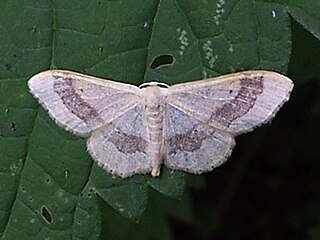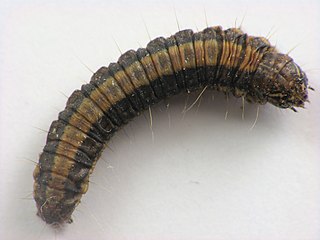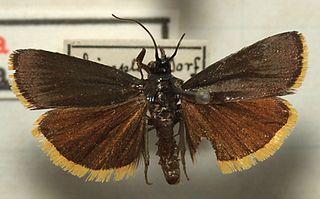Related Research Articles

Idaea, sometimes called Hyriogona, is a large genus of geometer moths. It was erected by Georg Friedrich Treitschke in 1825. They are found nearly worldwide, with many native to the Mediterranean, the African savannas, and the deserts of western Asia.

Though small in absolute diversity of genera, the Hemitheini are nonetheless the largest tribes of geometer moths in the subfamily Geometrinae. Like most Geometrinae, they are small greenish "emerald moths". The tribe was first described by Charles Théophile Bruand d'Uzelle in 1846.

Idia is a genus of litter moths of the family Erebidae first described by Jacob Hübner in 1813.

Hahncappsia is a genus of moths of the family Crambidae, and the order Lepidoptera.
Hydropionea is a genus of moths of the family Crambidae. The 13 described species are distributed in Central and South America.

Sigela is a genus of moths in the family Erebidae. The genus was erected by George Duryea Hulst in 1896.
Glaucina is a genus of moths in the family Geometridae erected by George Duryea Hulst in 1896.

Nemoria is a genus of emerald moths in the family Geometridae. It was named by Jacob Hübner in 1818.
Idia immaculalis, the immaculate idia, is a litter moth of the family Erebidae. The species was first described by George Duryea Hulst in 1886. It is found in North America from at least California, north and east across Montana to southern Alberta and Saskatchewan.

Trichopterygini is a tribe of geometer moths under subfamily Larentiinae. The tribe was described by Warren in 1894.

The Epipaschiinae are a subfamily of snout moths. Almost 600 species are known today, which are found mainly in the tropics and subtropics. Some occur in temperate regions, but the subfamily is apparently completely absent from Europe, at least as native species. A few Epipaschiinae are crop pests that may occasionally become economically significant.

Dioryctria is a genus of snout moths. It was described by Philipp Christoph Zeller in 1846.

Catastia is a genus of snout moths. It was erected by Jacob Hübner in 1825, and is known from Bosnia and Herzegovina, Austria, Italy, and Greece.
Catastia actualis is a species of snout moth in the genus Catastia. It was described by George Duryea Hulst in 1886. It is found from Saskatchewan and Alberta to Colorado and north-eastern California to Lake Tahoe.
Catastia bistriatella is a species of snout moth in the genus Catastia. It was described by George Duryea Hulst, in 1895. It is found in North America, including California.
Catastia uniformalis is a species of snout moth in the genus Catastia. It was described by George Hampson in 1903. It is found in India.
Eumysia is a genus of snout moths. It was described by Harrison Gray Dyar Jr. in 1925.

Sterrhini is a tribe of the geometer moth family (Geometridae), with about 825 species in 19 genera. There are also 6 genera with 36 species tentatively associated with the tribe. The tribe was erected by Edward Meyrick in 1892.
Caberini is a tribe of geometrid moths in the family Geometridae. There are at least 50 described species in Caberini.

Peoria is a genus of moths of the snout moth family (Pyralidae). The genus was erected by Émile Louis Ragonot in 1887.
References
- 1 2 Savela, Markku. "Catastia incorruscella (Hulst, 1895)". Lepidoptera and Some Other Life Forms. Retrieved August 11, 2019.
- ↑ Beccaloni, G.; Scoble, M.; Kitching, I.; Simonsen, T.; Robinson, G.; Pitkin, B.; Hine, A.; Lyal, C., eds. (2003). "Catastia incorruscella". The Global Lepidoptera Names Index . Natural History Museum . Retrieved April 28, 2018.
| This Phycitini-related article is a stub. You can help Wikipedia by expanding it. |